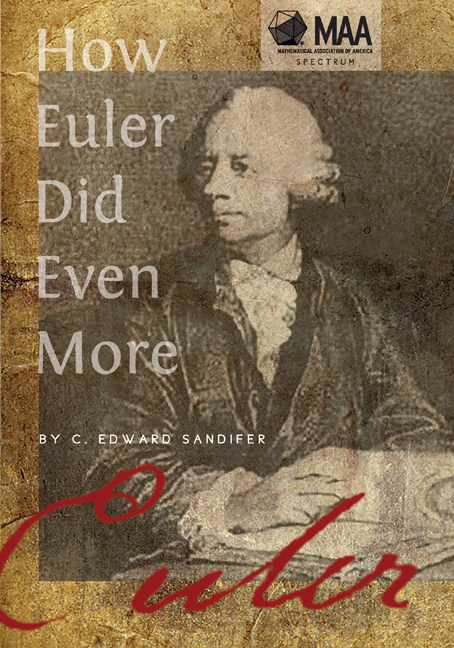Book contents
- Frontmatter
- Contents
- Preface
- Part I Geometry
- Part II Number Theory
- Part III Combinatorics
- Part IV Analysis
- 12 e, π and i: Why is “Euler” in the Euler Identity (August 2007)
- 13 Multi-zeta Functions (January 2008)
- 14 Sums of Powers (June 2009)
- 15 A Theorem of Newton (April 2008)
- 16 Estimating π (February 2009)
- 17 Nearly a Cosine Series (May 2009)
- 18 A Series of Trigonometric Powers (June 2008)
- 19 Gamma the Function (September 2007)
- 20 Gamma the Constant (October 2007)
- 21 Partial Fractions (June 2007)
- 22 Inexplicable Functions (November 2007)
- 23 A False Logarithm Series (December 2007)
- 24 Introduction to Complex Variables (May 2007)
- 25 The Moon and the Differential (October 2009—A Guest Column by Rob Bradley)
- Part V Applied Mathematics
- Part VI Euleriana
- About the Author
20 - Gamma the Constant (October 2007)
from Part IV - Analysis
- Frontmatter
- Contents
- Preface
- Part I Geometry
- Part II Number Theory
- Part III Combinatorics
- Part IV Analysis
- 12 e, π and i: Why is “Euler” in the Euler Identity (August 2007)
- 13 Multi-zeta Functions (January 2008)
- 14 Sums of Powers (June 2009)
- 15 A Theorem of Newton (April 2008)
- 16 Estimating π (February 2009)
- 17 Nearly a Cosine Series (May 2009)
- 18 A Series of Trigonometric Powers (June 2008)
- 19 Gamma the Function (September 2007)
- 20 Gamma the Constant (October 2007)
- 21 Partial Fractions (June 2007)
- 22 Inexplicable Functions (November 2007)
- 23 A False Logarithm Series (December 2007)
- 24 Introduction to Complex Variables (May 2007)
- 25 The Moon and the Differential (October 2009—A Guest Column by Rob Bradley)
- Part V Applied Mathematics
- Part VI Euleriana
- About the Author
Summary
Sam Kutler, now retired from St. John's College in Annapolis, once pointed out that there are three great constants in mathematics, π, e and γ, and that Euler had a role in all three of them. Euler did not discover e or π, but he gave both of them their names. In contrast, Euler discovered, but did not name γ, the third and least known of these constants.
This γ is usually known as the Euler-Mascheroni constant, acknowledging both the work Euler did in discovering the constant in about 1734, (more on this later) and the work of Lorenzo Mascheroni (1750–1800). Mascheroni was a priest and a professor of mathematics at the University of Pavia in Italy. As Mascheroni studied Euler's books on integral calculus, he took careful notes and extended several of Euler's results, especially those involving the constant that now bears his name. Mascheroni published his notes in 1790 under the title Adnotationes ad calculum integrale Euleri. The editors of Euler's Opera Omnia have republished Mascheroni's Adnotationes as an appendix to the second volume of Euler's integral calculus in Series 1 volume 12 of the Opera Omnia. Mascheroni's Adnotationes are a model of a wonderful way to learn mathematics: find an excellent book on the subject and work through it, theorem by theorem, working examples, checking proofs, and extending results when you can. It doesn't make very exciting reading, though. It's a bit like reading someone else's homework assignments, watching that person struggle, but eventually master difficult concepts.
Euler made his first steps towards discovering gamma the constant in the same letter to Christian Goldbach dated October 13, 1729 in which he also first mentioned gamma the function. Goldbach and Daniel Bernoulli had been working on “interpolating a sequence” by finding a function that “naturally expresses” the sequence, and that is also defined for fractional values. We learned in last month's column how the gamma function interpolates the series of factorial numbers.
Bernoulli and Goldbach were also working, without much success, to interpolate the partial sums of the harmonic series.
Information
- Type
- Chapter
- Information
- How Euler Did Even More , pp. 136 - 140Publisher: Mathematical Association of AmericaPrint publication year: 2014
